
March 12-30 - Cottonwood, AZ
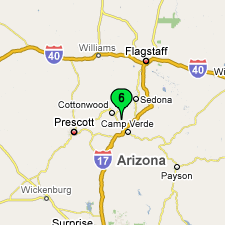 On the way east from Bullhead City, we stopped to fuel the RV in Kingman, AZ - and realized it was only the second time we'd bought RV gas this year. That's a pretty nice pace. Doubt we can sustain that level of immobility, though. On the way east from Bullhead City, we stopped to fuel the RV in Kingman, AZ - and realized it was only the second time we'd bought RV gas this year. That's a pretty nice pace. Doubt we can sustain that level of immobility, though.
Heading east from Kingman on I-40 we passed south of the Grand Canyon, headed for the 1000 Trails Verde Valley RV park near Cottonwood, AZ. Between Williams and Flagstaff at nearly 7,000 ft elevation, we started seeing snow piled alongside the highway, and snow on the ground back in the trees. Then we started seeing it on our windshield. Temperatures dropped to 34 degrees at one point. We drove for about 20 minutes through a pretty good snow shower, wondering all the while if we'd made a mistake by coming this way. But after we headed south from Flagstaff and started descending to lower elevations, the snow stopped and the temperatures rose, and by the time we got to our destination, the sun was shining and the temperature was around 75. We decided we'd stay a while.
We'd spent part of one day in the Sedona-Cottonwood-Jerome area in 2006, so we were kind of prepared for the beauty of the area. This time, we had a whole three weeks to explore it. We easily could have spent more time, because we never did get to everything we wanted to see.
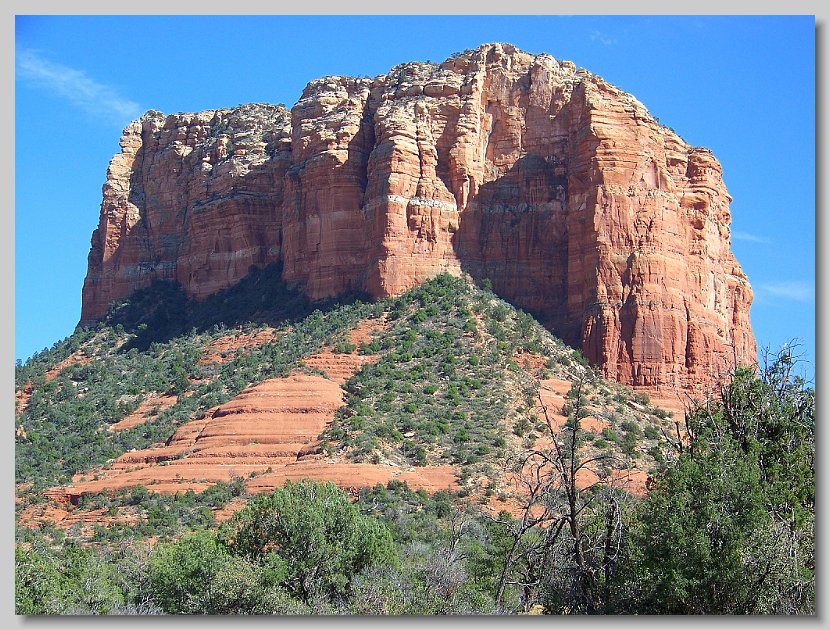 It's hard to adequately describe the scenery around Sedona. The Red Rocks area of the Verde Valley is absolutely spectacular. It's like living in a Roadrunner cartoon. You expect to see Wile E. Coyote zipping across the highway hanging on for dear life astride something he ordered from the Acme Company. We can't imagine ever getting tired of those views. It's hard to adequately describe the scenery around Sedona. The Red Rocks area of the Verde Valley is absolutely spectacular. It's like living in a Roadrunner cartoon. You expect to see Wile E. Coyote zipping across the highway hanging on for dear life astride something he ordered from the Acme Company. We can't imagine ever getting tired of those views.
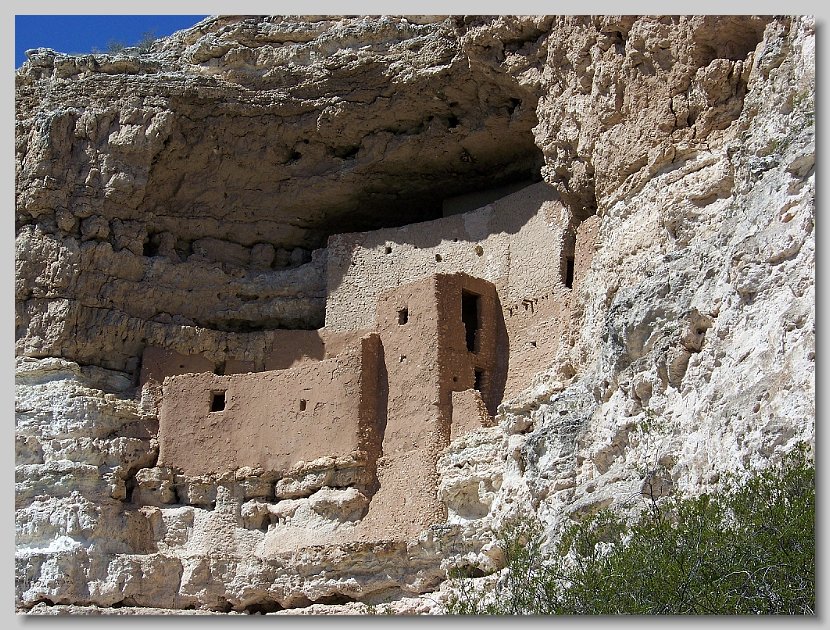 The Verde Valley, created by the Verde River, was fertile territory for the Native Americans who lived and farmed the area from about 400 to about 1450 AD. But by the time the first Spanish explorers got there in the mid-1500s, the native population was gone. Nobody knows why they left or where they went. They left behind the ruins of some impressive communities, many of which are now protected, excavated and available for visitation. The archeologists have learned a lot about these folks, and it appears they had an extensive trading system that extended over 1,000 miles south, east and west. We were able to visit Montezuma's Castle, a wonderfully preserved cliff dwelling complex that had once been home to around 1,000 people, and nearby Montezuma's Well where a couple hundred people lived, and where an irrigation canal had been dug to redirect water from the spring-fed lake to the fields where they grew corn. Both had
been misnamed by the Spanish explorers who assumed the ruins were Aztec. The Verde Valley, created by the Verde River, was fertile territory for the Native Americans who lived and farmed the area from about 400 to about 1450 AD. But by the time the first Spanish explorers got there in the mid-1500s, the native population was gone. Nobody knows why they left or where they went. They left behind the ruins of some impressive communities, many of which are now protected, excavated and available for visitation. The archeologists have learned a lot about these folks, and it appears they had an extensive trading system that extended over 1,000 miles south, east and west. We were able to visit Montezuma's Castle, a wonderfully preserved cliff dwelling complex that had once been home to around 1,000 people, and nearby Montezuma's Well where a couple hundred people lived, and where an irrigation canal had been dug to redirect water from the spring-fed lake to the fields where they grew corn. Both had
been misnamed by the Spanish explorers who assumed the ruins were Aztec.
In the Cottonwood area, we toured the Tuzigoot ruins, a large pueblo built atop a hill that once was home to several native families. That area was all excavated and opened as a national monument as a Federal make-work project during the 1930s. The name is an Apache word meaning "crooked river", although the people were most certainly not Apache. The vanished residents 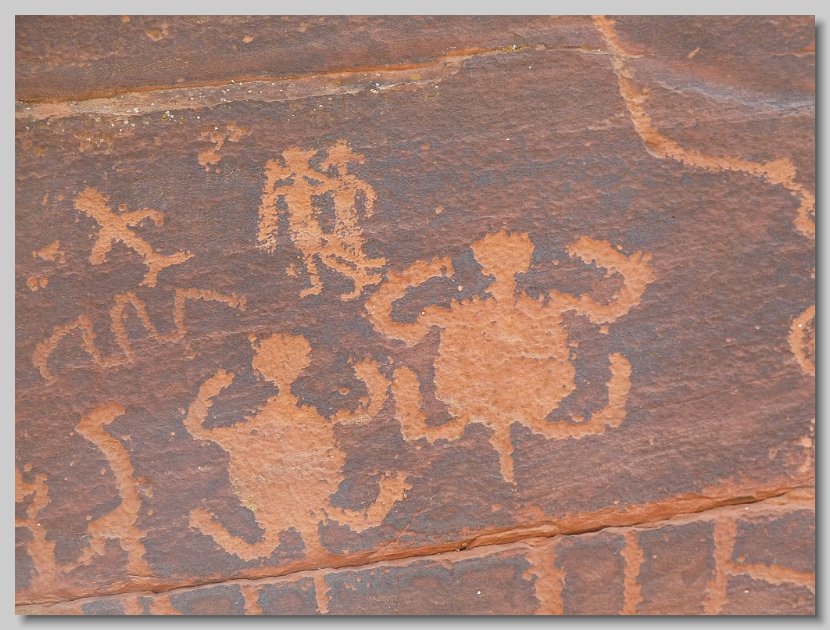 were named the Sinagua ("without water") by the Spanish, but nobody knows what they called themselves. Our big surprise was a serendipitous visit to the V-Bar-V Ranch near Camp Verde, where there's a marvelous Sinaguan petroglyph site. Just so happened we were there for the Equinox, along with many others who had come for special archeological programs. We tagged along, and managed to be at the petroglyphs at precisely the moment when the sun, rocks, carvings and shadows aligned to tell us it was time to plant the corn. That was very cool. Other archeological digs in the area have uncovered evidence of complex societies going back several thousand years. Primitive people, indeed. And then they were gone. were named the Sinagua ("without water") by the Spanish, but nobody knows what they called themselves. Our big surprise was a serendipitous visit to the V-Bar-V Ranch near Camp Verde, where there's a marvelous Sinaguan petroglyph site. Just so happened we were there for the Equinox, along with many others who had come for special archeological programs. We tagged along, and managed to be at the petroglyphs at precisely the moment when the sun, rocks, carvings and shadows aligned to tell us it was time to plant the corn. That was very cool. Other archeological digs in the area have uncovered evidence of complex societies going back several thousand years. Primitive people, indeed. And then they were gone.
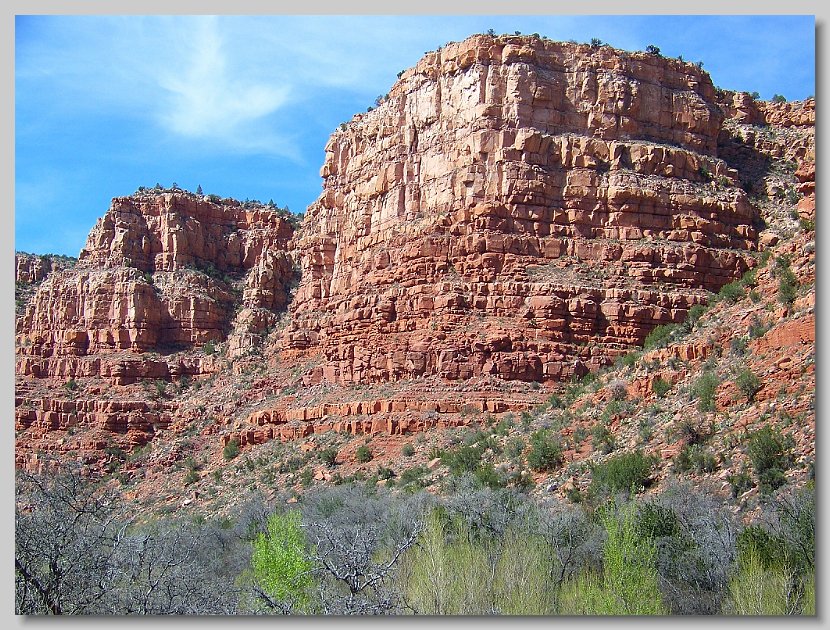 We took a ride on the Verde Canyon Railroad, which offers an excursion into "Arizona's Other Grand Canyon". They do not exaggerate. The 40-mile train ride - 20 out, 20 back - follows the Verde River from Clarkdale to a ghost ranch at Perkinsville, and most of the area the train traverses is only accessible by rail. There are trestles and tunnels and bridges, there are cliff dwellings and eagles' nests and spectacular views, and then there's that amazing canyon. It's not as big or as deep as that other Grand Canyon north of here, but from the bottom looking up, it's plenty spectacular. The railroad was originally built to haul copper ore from the mines in Jerome to the smelter in Clarkdale. But when the copper played out in the 1950s, the railroad traffic decreased dramatically. In the early 1990s, the excursion trains were started, and have since carried over a million passengers. But what goes around, comes around. In January,
work began to mine the 40 acre slag heap left by the old Clarkdale smelter. They're expecting that with modern technology and processing methods, there's enough gold, silver, nickel, copper and other metals in that discard heap to keep them busy (and presumably profitable) for at least another 20 years. We took a ride on the Verde Canyon Railroad, which offers an excursion into "Arizona's Other Grand Canyon". They do not exaggerate. The 40-mile train ride - 20 out, 20 back - follows the Verde River from Clarkdale to a ghost ranch at Perkinsville, and most of the area the train traverses is only accessible by rail. There are trestles and tunnels and bridges, there are cliff dwellings and eagles' nests and spectacular views, and then there's that amazing canyon. It's not as big or as deep as that other Grand Canyon north of here, but from the bottom looking up, it's plenty spectacular. The railroad was originally built to haul copper ore from the mines in Jerome to the smelter in Clarkdale. But when the copper played out in the 1950s, the railroad traffic decreased dramatically. In the early 1990s, the excursion trains were started, and have since carried over a million passengers. But what goes around, comes around. In January,
work began to mine the 40 acre slag heap left by the old Clarkdale smelter. They're expecting that with modern technology and processing methods, there's enough gold, silver, nickel, copper and other metals in that discard heap to keep them busy (and presumably profitable) for at least another 20 years.
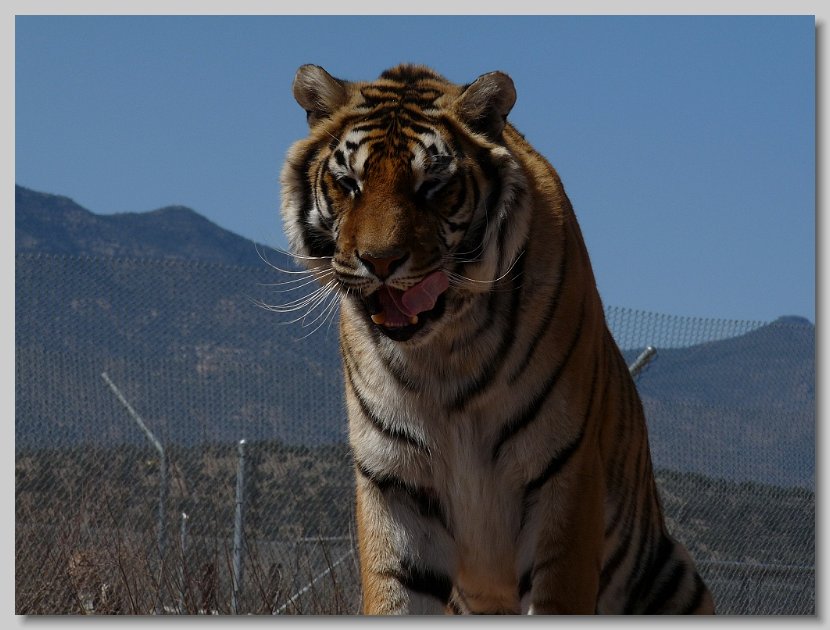 A few miles south of the RV park is the Out of Africa Wildlife Park. We're suckers for wildlife parks, and this one did not disappoint. You get a "Serengeti Tour" through one of the animal compounds, where the ostriches and giraffes and zebras and other residents come right up to the bus. They give you stuff to hand feed the animals, and that's a lot of fun. And then you get to wander around the acres and
acres of habitats. These animals have plenty of space to roam, and sometimes that makes seeing them a challenge. The park seems to specialize in tigers; there are probably a couple dozen of them in various enclosures. A few of the tigers interact with their trainers in a "Tiger Splash" event in a stadium pool. Really neat place. A few miles south of the RV park is the Out of Africa Wildlife Park. We're suckers for wildlife parks, and this one did not disappoint. You get a "Serengeti Tour" through one of the animal compounds, where the ostriches and giraffes and zebras and other residents come right up to the bus. They give you stuff to hand feed the animals, and that's a lot of fun. And then you get to wander around the acres and
acres of habitats. These animals have plenty of space to roam, and sometimes that makes seeing them a challenge. The park seems to specialize in tigers; there are probably a couple dozen of them in various enclosures. A few of the tigers interact with their trainers in a "Tiger Splash" event in a stadium pool. Really neat place.
We'd only been in the area a couple of days when we discovered the Hog Wild Barbeque in Old Town Cottonwood. We ate there too many times, including once with our niece Beth and her Mike, passing through while driving Beth's new engagement ring from California to Michigan. They then came back to the motorhome to visit a bit. For them, the two weeks they're taking to drive to Michigan is a leisurely trip. For us, it sounds positively hectic. Ahh, youth.
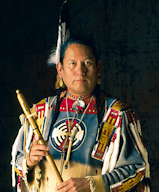 Judy's been playing the Native American Flute for a few years now, and early on discovered the recordings of R. Carlos Nakai, a classically-trained Apache-Ute Indian, and unquestionably the premiere Native Flute player. We spotted a sign that he'd be playing in Cottonwood with his group The Wilde Boys. We immediately bought tickets, and the concert was wonderful. And as great as Nakai was with his flutes, we were especially impressed by William Eaton, the guitarist of the group. He makes his own unique instruments, and, as they are all one-offs, is the only person who ever plays them. 20 string guitars. Lyres with frets. And, by the end of the show, you realize some of them are actually synthesizers. We stole some pictures of some of the instruments from his website. They are absolutely fascinating. Judy's been playing the Native American Flute for a few years now, and early on discovered the recordings of R. Carlos Nakai, a classically-trained Apache-Ute Indian, and unquestionably the premiere Native Flute player. We spotted a sign that he'd be playing in Cottonwood with his group The Wilde Boys. We immediately bought tickets, and the concert was wonderful. And as great as Nakai was with his flutes, we were especially impressed by William Eaton, the guitarist of the group. He makes his own unique instruments, and, as they are all one-offs, is the only person who ever plays them. 20 string guitars. Lyres with frets. And, by the end of the show, you realize some of them are actually synthesizers. We stole some pictures of some of the instruments from his website. They are absolutely fascinating.
We visited the delightful Verde Valley Presbyterian Church of Cottonwood all three Sundays we were in the area. It's a smaller church, and reminds us a lot of our home church in Reedsport. The pastor is Bobbye Clark, who started seminary when she was 60. Her husband Bob is a retired Presbyterian minister. As we were leaving on our last Sunday, she asked us if we knew Dick Smith. Wow! Dick Smith was the original pastor of the Presbyterian Church in Florence, OR, and he and Harriet are special friends of our church
in Reedsport. Seems that Dick and Bob Clarke have been friends for a long time, and the Smiths will be visiting in Arizona in April. Small world.
Shortly before leaving Cottonwood, we celebrated our 17th wedding anniversary, and also two years of living in our motorhome. We went out for a special dinner - Judy had quail, Al had buffalo. Sure doesn't seem like 17 years. Time sure flies when you're having fun.
We started out with over 2,500 pictures from these three weeks. Judy's done a Herculean job of culling, and it's now down to around 200 for the slideshow. Click here to see the surviving pictures.
|

 On the way east from Bullhead City, we stopped to fuel the RV in Kingman, AZ - and realized it was only the second time we'd bought RV gas this year. That's a pretty nice pace. Doubt we can sustain that level of immobility, though.
On the way east from Bullhead City, we stopped to fuel the RV in Kingman, AZ - and realized it was only the second time we'd bought RV gas this year. That's a pretty nice pace. Doubt we can sustain that level of immobility, though. Judy's been playing the Native American Flute for a few years now, and early on discovered the recordings of R. Carlos Nakai, a classically-trained Apache-Ute Indian, and unquestionably the premiere Native Flute player. We spotted a sign that he'd be playing in Cottonwood with his group The Wilde Boys. We immediately bought tickets, and the concert was wonderful. And as great as Nakai was with his flutes, we were especially impressed by William Eaton, the guitarist of the group. He makes his own unique instruments, and, as they are all one-offs, is the only person who ever plays them. 20 string guitars. Lyres with frets. And, by the end of the show, you realize some of them are actually synthesizers. We stole some pictures of some of the instruments from his website. They are absolutely fascinating.
Judy's been playing the Native American Flute for a few years now, and early on discovered the recordings of R. Carlos Nakai, a classically-trained Apache-Ute Indian, and unquestionably the premiere Native Flute player. We spotted a sign that he'd be playing in Cottonwood with his group The Wilde Boys. We immediately bought tickets, and the concert was wonderful. And as great as Nakai was with his flutes, we were especially impressed by William Eaton, the guitarist of the group. He makes his own unique instruments, and, as they are all one-offs, is the only person who ever plays them. 20 string guitars. Lyres with frets. And, by the end of the show, you realize some of them are actually synthesizers. We stole some pictures of some of the instruments from his website. They are absolutely fascinating.